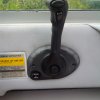docmirror
Touchdown! Greaser!
- Joined
- Jan 5, 2007
- Messages
- 12,008
- Display Name
Display name:
Cowboy - yeehah!
Quick check on the jet is to shine a flashlight in from the front intake, and look in at the impeller from the rear. Look for the gap around the impeller, and any gouges along the impeller path. Once the jet housing gets worn, the ski won't have much get up and go.



